Conversation with Carolee Schneemann (Part II)
by Odili Donald Odita
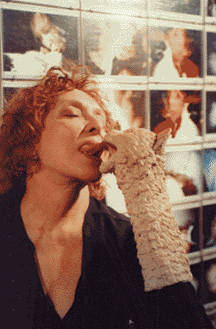 |
Carolee Schneemann |
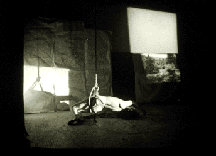 |
Up To And Including Her Limits, 1973-76.
Performance/Installation;
Crayon on paper, rope,
harness, video, Super 8 film relay. |
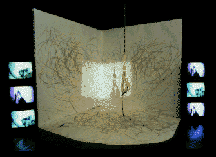 |
Up To And Including Her Limits, 1973-76.
(Detail - 1976) Performance/Installation;
Crayon on paper,
rope,harness, video,
Super 8 film relay. |
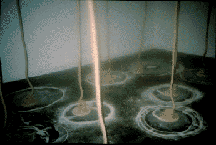 |
Mortal Coils, 1994-95. (Detail)
Multimedia Installation:
4 slide projector units
with motorized mirror systems,
17 motorized manila ropes,
suspended and revolving
from ceiling units,
"In Memorium" wall scroll text. |
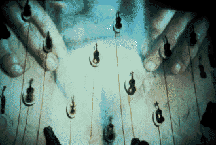 |
Cycladic Imprints, 1993.
Performance/Installation. |
PART II
ODO: How would you discuss Up to and Including Her Limits in relation to the artist Matthew Barney? For example, in comparing it to his New York debut at Barbara Gladstone gallery? I'll add, when in fact, after seeing your piece, Up to and Including Her Limits, a piece I was not aware about when I was standing in that gallery looking at Mr. Barney's work. Basically, it's an extension of that piece. It comes from that piece.
CS: I'm always happy when people see extensions of my work where I might see it as well. This is one piece that many people see, and so Matthew Barney must have heard at some point that so many people are being reminded of this precedence. And of course, the book, More Than Meat Joy was published in 1977, and hit a whole generation of art students who found ideas, inspirations, permissions in it, and certainly Matthew Barney is only one of many kinds and forms of actions that I see coming and going that make me think, ' Didn't I do that? Is it mine? Can I use this?'
ODO: And is that a question you still have, think about, or are you at a point where you are beyond that? I don't like getting into this negative space but at the same time, it's something that annoys me greatly. Especially when there's an irrational fascination or preoccupation, in this case in Matthew Barney, when the people who go about describing his value lose all reason discussing it. I wanted to talk with you a little bit about this absurdity. I want to know if you think the same, especially of an artist like Barney when it really speaks about the promotion machine.
CS: Well I can't speak to it except to have my usual wonder as to why I'm so unattractive to any promotion machines. I'm some part of nature that just keeps pouring and pouring and pouring.
ODO: I would only have to say that there are artists that are very difficult for the mainstream. Do you think that America and its predilection for entertainment bars them from engaging in issues more thought-provoking in art, such as feminism, class and race, for example?
CS: There's several things. Entertainment in popular forms sanitizes the underlying social issues of class, race and gender. Even though there are things on TV that would have been unimaginable even five years ago, and one of the wonderful things that American culture has is a wacky, irreverent, seductive humor. I don't find it anywhere else in the world. When I live abroad, and I learn another language and I'm subsumed in that other culture, I begin to dream of an inane, almost Dadaist radicalism of American humor, which has a way of pulling issues through the self-righteousness, the religiosity, the reactionary suppressiveness that's also part of our culture--so we're always between these poles. And artists have this huge dilemma of belonging to a form that's utterly despised and mistrusted, artists are considered like semi-terrorists or bums, I mean, people still say to me, ' When are you going to get a job?' And they're right! Still we have the privilege of self-direction, self-definition, and the ability-in some consequential instances- to resist, to provide a radicalizing example, (I could mention Adrian Piper, Hans Haacke, Suzanne Lacy, Fred Wilson, David Hammons, Martha Rosler, Mel Chin, Daniel Martinez).
ODO: What you just said was interesting to me. The fact that there underlying social issues within American culture and entertainment. Say for instance, The Odd Couple. To me, The Odd Couple is about this gay relationship, but it's all hidden, it's all layered under their jokes.
CS: But it's kind of adorable, because some of us know and the rest of us don't.
ODO: But at the same time, I think that there's a certain kind of poverty in not being able to push that envelope even further, that it has to stay at this place of just being The Odd Couple. Ellen is another example. Now she's coming out, after how many years of this kind of closeted thing on television. Now she comes out and it's a big hoop-de-doo, but it's still this very safe, very sanitized thing. It's plotted.
CS: But you know, this is absolutely wonderful for people in the middle of Indiana who have been in the closet forever. To be able to say, ' Here's a cultural figuration about us, which means maybe our landlord won't try to kick us out. Maybe the guy in the service station doesn't want to take his rifle and blow our brains out. Maybe the creep following us when we go on our camping trip is not going to try to rape us and murder us.' This is seductive to some artists, because the only way that we can ostensibly enter popular culture is to be part of MTV, to get to Hollywood.
ODO: I guess what I am saying is that it's not enough. It's not enough.
CS: I don't believe in it either, but...
ODO: I saw Julian Schnabel on Charlie Rose. I borrowed a tape from a friend of mine, and I thought that I had lost brain cells after watching their conversation about his horror movie, 'Basquiat.'
CS: How many did you lose?
ODO: Quite a few. I couldn't believe that I had watched this thing from beginning to end, I couldn't believe it. For me, it's a pleasure to listening to you about the things you've said about your work. It's so thorough. You're the kind of artist that I always envision a true artist to be.
CS: Thanks a lot. And if we were so smart how come we're so poor, huh?
ODO: Dan Cameron said, in the catalogue that your work is championing the validity of sensual pleasure. I would like to ask you what you think he might have meant by that, and how this applies to your work?
CS: Maybe he meant that my pleasure in the body and my pleasure in sensuality, and my expectation of pleasure and erotic satisfaction, has to do with some power I assume with my material, that they are part of this energy. A plateau in which I cannot be dislodged by the phobic, the fetishistic, the projections of Sadomasochism and fetishism. I maintain the transposition of the body as a source of knowledge and ecstatic pleasure--this is not a useful example for everybody because if your pleasure and your experience of the body has been damaged, or interfered with, or hurt, then you're not going to be able to assume the position that I assume.
ODO: Right. But one has to learn how to get to that liberation...
CS: Maybe, but maybe not. Anyway, it's an example of a feminist experience. A woman who has authority over the experience of her erotic history.
ODO: You say maybe, maybe not. That's interesting to me because before you said that we all should try to get to a place where we can understand ourselves.
CS: Where you might understand yourself by realizing that you have to put pins all over your body because that's the only correlative to the violence that was done to you when you were four years old.
ODO: That's acceptance. That's to accept that everybody has some kind of fucked up thing that happened to them in their past. It's their brother that did something to them, their mother, or they were alone, or just finding something, or hearing something. And let's say they do need to beat themselves, or be beaten, or whatever. But it's to accept it, not to say you're cursed because you have to have needles in yourself at the end of the day, or that you sleep in a cardboard box or something like that. I found this book ' Angry Women?
CS: Yes. Absolutely I'm in it.
ODO: I came across Annie Sprinkle, and another person, Susie Bright. After reading Annie Sprinkle's piece, I felt that this was someone trying to truly liberate herself.
CS: Not just herself, she's liberating anyone who has permission to experience a natural voyeurism, to see inside the feminine as not something taboo and terrifying and hideous and grotesque and wet and slimy, but to say, ' This is very ordinary and I'm offering it to everybody, because this is the only way to break the fetishistic, phobic games.' I always say we're in this incredibly fortunate moment. I mean, women are allowed to speak, we're not mutilated, we're not wrapped up, we're not locked in the kitchen, and it's very terrifying for the traditional male in this society.
ODO: Annette Michaelson, bought up the term ' visual culture' to say that maybe this was something that could be applied to these artists to help reign them in, not frame them. To put them on a frame of discourse, where you can speak again about the elements within their work. Do you see the term ' visual culture' coined by Ms. Michaelson in the catalogue as the expansion of the field of art history, or the ghettoization of rebel artists such as yourself who challenge the conventions of art history?
CS: You know, the text in Interior Scroll? This text is a secret letter to Annette Michaelson, because she somehow over all these years never got to see my work or my films, and I felt that she was a most important cultural historian that I would like to have consider my work.
ODO: It's interesting, sometimes these people that we find connection to just may not get it, because they come from a different place.
CS: Or a different body. Or a different race, or gender, or something very powerful pulls them away.
ODO: When these art historians bring in this term visual culture, do you think that it does help define your work and place it fairly within a context equally alongside your peers? Or do you think it's a form of ghettoization and a separation?
CS: I have no idea because they haven't really examined my work. I would like to know if visual culture means that people are able to perceive what's right in front of their faces more clearly?
ODO: It's dealing with the real world, it accepts the real world a bit more.
CS: Oh, hooray, huh?
ODO: Being an artist who works partly with Modernism as a dialect, I see how Modernism creates a frame around itself and the objects that define it, and how Modernist works rarefy themselves to the point of becoming extinct.
CS: A little death wish here, huh?
ODO: Yeah, but it seems like these historians are also doing the same thing in their analysizations and work. If they can come out and say, ' Because your work falls outside of the terms that we have used historically, rather, in the past, we don't merit your work as art.' Then that is a very, very terrible thing. And this may be the case with artists like yourself that challenge what we know as art. Because they can't talk about it, they just say, ' It's not art.' And then to bring in the term visual culture, it seems as if they're trying to include you, but in effect, they're 'othering' you.
CS: Well they're tossing a little dried bone, in England it would be called a dried biscuit. They just threw a dried biscuit in my direction. And when you have a big hungry dog, it's not going to be happy with a dried biscuit. It has visions of whole shanks and shoulders, and even their brains, chomp-chomp-chomp.
ODO: On one level I see Up to and Including Her Limits as a re-interpretation of the act of art making. It embodies the whole notion of art making in a way, just yourself as an artist and instrument. And it's interesting that artists that sometimes are very intelligent and outside of the mainstream, re-invent the whole process for themselves so that they can then enter the picture. Maybe that's what Picasso did. Maybe Picasso's madness was about re-inventing something for himself too.
CS: Of course it was.
ODO: Why does somebody make so many things, though? So many different things, so many challenging things.
CS: Because it's like breathing, it's like your next breath, and you're not really alive unless you're seeing, you have to keep seeing what can be invented through you.
ODO: But I think Picasso also just seems so forceful, to the point that it not only destroys himself, but others as well, because he was able to make things that the world accepted, and then he would break them to go on to something else.
CS: Well you don't want to be inhabited by your own practice. Let other people grab it. You have to propose another possibility. But on the other hand you can keep going in some kind of intense intimacy, Villiard is such a wonderful example for me of someone who just hunkered in. He had a cosmology in a teacup.
ODO: There are those people I do admire. People that stay with something that looks conservative on the outside, but it's not at all. Those people are interesting too, because they take that Odd Couple thing and go further.
CS: They just stay there and stay there and stay there, and it gets more and more intense and amazing.
ODO: Is that what painting was then for you, because you're an artist who breaks things.
CS: Yeah, I keep breaking things, I have to, because if I don't break things they're going to catch me and kill me. It's real simple.
ODO: Who is they?
CS: The culture. I mean, they'll catch me and kill me anyway, but they'll catch me and kill me in the predictability of what they want. And since I'm never acceptable anyhow, I need to keep moving.
ODO: That's what happened to Basquiat. He became acceptable, and then he was dead. I mean, to the last day they hated him it seemed, and then once he was dead, it was like going back to the garage sales and flea markets and getting all that stuff of his they threw away.
CS: It's foul. Same as Ray Johnson, same as every neglected artist I know. They think you're a maniac until you're dead. ' Oh, what a wonderful angel. Dead.' And who gets all that money? The vultures, with their big flapping wings.
ODO: Do you feel that women can have a gaze outside of Western male reality? Or do they have a gaze given to them within this reality?
CS: Well, you know, the funny thing is women have always had their own gaze, and then it's confabulated by the conventions of culture around us. It's very interesting to women to discover that in Egypt, and China and Africa, and in Paleolithic shards, we find embellishment of the body over and over again. And that it's something possibly innate about the pleasure of the sensuousness of the body and its embellishment, that may or may not have anything to do with male fantasies of what provokes or satisfies him. Embellishment is also about celebration and power, and affinity with the elements that are around you. Basic expressivities have been dumped into this whole pot of everything constructed by male culture and imagination, which takes away originating powers and directions of the feminine as a force field in itself. And then, when originating powers of the feminine are described as essentialist, you've got nothing left at all except back in the same old palm of the male hand, where all meaning must be. So I just dump all that, and my position has always been to invert and reinvent attributes and iconographies, and I take from them all shamelessly.
ODO: That's fine...
CS: It may not be fine, because I'm stealing without knowing.
ODO: That's another thing. That's another thing altogether. I'm not a judge. I just feel that there are a lot of people who don't have any consideration when they do take. For instance there's this painter named Phillip Taaffe. Now I could think, what is his relationship with the motifs that he's taken? Is he a tourist who shops, or is he somebody who really...
CS: A tourist always shops, always.
ODO: But is he a tourist who shops just to re-sell his wares in America at double the price? Or is he someone who's really invested in the territory he's working in? That's a question I could ask him.
CS: You already have your intuition in that.
ODO: I'm just trying to understand what these people are actually taking.
CS: But that's what I have to do, is to look through culture to find some precedence. And that's what I have been able to provide to some other artists, is a form of precedence.
ODO: Okay. What beyond just the moral and I would say, heroic aspects you just mentioned, what other things do you find that you are concerned with in your future work?
CS: I'm very touched when people who have as much sensibility as you do are interested in the work. That stuff seems pretty remarkable to me, because I have a very split image of my own position. One image of my position is that of a really ragged, angry skinny dog, running around the edge snarling, expecting to be kicked and have food taken away. But it keeps going, nothing can stop it.
ODO: It keeps pacing?
CS: It runs in a big circle around this world that keeps it out, and it won't leave. It never goes away. It sleeps and it wakes, and it's a skinny, emaciated, angry, it's an ugly dog, that's one aspect of myself. The other aspect is this sort of magnificent goddess who represents some sort of ideality that can pour and flourish and shock and comfort that keeps, it's in constant production. And it's bonded with this dog, maybe by a long rope, or an umbilicus. They never leave each other. So I would like those two to get closer.
© Carolee Schneemann and Odili Donald Odita, 1997.
Copyright ©1998 PLEXUS Art and Communication & the Authors All Rights Reserved
|